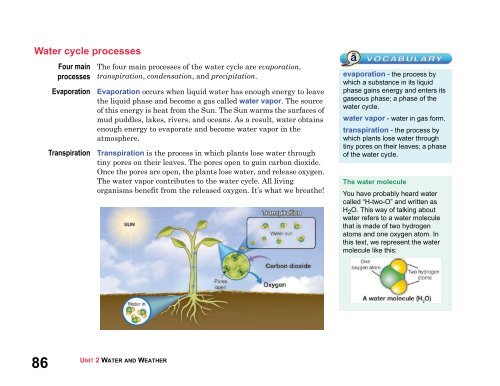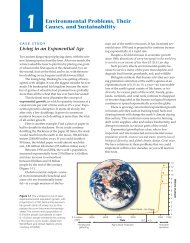Unit 2 Water and Weather - Spokane Public Schools
Unit 2 Water and Weather - Spokane Public Schools
Unit 2 Water and Weather - Spokane Public Schools
You also want an ePaper? Increase the reach of your titles
YUMPU automatically turns print PDFs into web optimized ePapers that Google loves.
<strong>Water</strong> cycle processesFour mainprocessesEvaporationTranspirationThe four main processes of the water cycle are evaporation,transpiration, condensation, <strong>and</strong> precipitation.Evaporation occurs when liquid water has enough energy to leavethe liquid phase <strong>and</strong> become a gas called water vapor. The sourceof this energy is heat from the Sun. The Sun warms the surfaces ofmud puddles, lakes, rivers, <strong>and</strong> oceans. As a result, water obtainsenough energy to evaporate <strong>and</strong> become water vapor in theatmosphere.Transpiration is the process in which plants lose water throughtiny pores on their leaves. The pores open to gain carbon dioxide.Once the pores are open, the plants lose water, <strong>and</strong> release oxygen.The water vapor contributes to the water cycle. All livingorganisms benefit from the released oxygen. It’s what we breathe!evaporation - the process bywhich a substance in its liquidphase gains energy <strong>and</strong> enters itsgaseous phase; a phase of thewater cycle.water vapor - water in gas form.transpiration - the process bywhich plants lose water throughtiny pores on their leaves; a phaseof the water cycle.The water moleculeYou have probably heard watercalled “H-two-O” <strong>and</strong> written asH 2 O. This way of talking aboutwater refers to a water moleculethat is made of two hydrogenatoms <strong>and</strong> one oxygen atom. Inthis text, we represent the watermolecule like this:86UNIT 2 WATER AND WEATHER

















